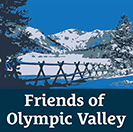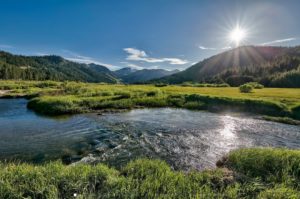Olympic Valley approves Wildfire Protection Plan
Olympic Valley Public Service District approved of a community wildfire protection plan at its meeting on Tuesday.
Reprinted from the Sierra Sun
Justin Scacco jscacco@sierrasun.com
OLYMPIC VALLEY, Calif. — The Olympic Valley Public Service District has approved a plan aiming to reduce wildfire risks in the area.
The Olympic Valley Community Wildfire Protection Plan was approved of by the district at its Tuesday meeting and will now be reviewed by Cal Fire, USDA Forest Service, Firewise USA and the Placer County Board of Supervisors for approval.
“We need to make the fuels discontinue on a large scale, not just in your backyards but outside your backyards as well,” said professional forester Jeff Dowling during a presentation on the protection plan.
The purpose of the plan is to identify and prioritize fuel reduction and create a wildfire prevention strategy. Creating a community wildfire protection plan is a necessary step in obtaining state and federal funding, according to Zeke Lunder, founder of Deer Creek Resources, which was contracted by the district to consult on the plan.
“Our job with these planning projects is kind of to be your Hollywood screenwriter and imagine what most people don’t like to imagine happening,” said Lunder.
Deer Creek Resources identified several assets within Olympic Valley that are at risk of wildfire, including high voltage power lines, an AT&T Pac Bell Switching Station, district infrastructure, Palisades Tahoe ski resort infrastructure, 13 bridges on public and private roads, communication lines and others.
The entire community and surrounding area, except for the meadow, is categorized as a very high fire hazard severity zone. Roughly 20% of lots smaller than one acre within Olympic Valley have heavy loadings of ladder fuels, with about 35% showing moderate levels of ladder fuels. A 2021 LiDAR scan showed that more than 50% of all lots under one acre had some level of ladder fuels present. Ladder fuels are a concern, because they can carry a surface fire into the canopy above.
Several wildfire scenarios could deliver a large fire to the area, according to the wildfire protection plan. North and east winds generally arrive in the late fall and are very dry. These could carry a fire starting in North Lake Tahoe or the Truckee area toward the community. Another scenario is a fire starting on the west side of the Sierra Crest burning across the divide and into the community from the west. While the relatively sparse vegetation in the high country to the west of Olympic Valley has in the past been looked at as a reliable fuel break, the 2021 Caldor Fire showed it is possible for drought-driven wildfires to traverse the Sierra Nevada.
Ladder fuels in the region could lead to tree torching, which occurs when a fire jumps into the crowns of the taller trees. Torching is referred to as “problem fire behavior,” according to the protection plan, as it is usually accompanied by long-range spotting, which spreads the fire over control lines. Spotting is the primary reason firefighters were unable to corral major fires such as the Caldor or Dixie.
“What we’re seeing on fires like the Dixie or the Caldor is that it can start a fire a mile away,” said Lunder.
Priorities include thinning the north side of the valley slope, creating a 150-foot buffer around the edge of the community, improving road access, improving water supply and water delivery, and reducing hazardous fuels around homes and structures.
“If you have house fire on a bad day we don’t want the house fire to become a forest fire,” said Lunder. “But also because we anticipate that if we have a fire in the backcountry and we’re fighting it in the community, it just buys the fire fighters a lot of advantages to have reduced fuels in this zone.”
Lunder added that during the Camp Fire in 2018, once structures caught fire there was little firefighters could do to save homes in the town of Paradise.
“When they took all the data and looked at every factor that drove why the fire was so destructive, the most significant factor was if you had another building within 60 feet of your house that burned, it was almost impossible that your wouldn’t burn,” he said.
The Olympic Valley Public Service District serves a population of roughly 924 people year-round, with a maximum overnight population of 6,500 people. Residents and visitors are housed in roughly 663 residential units, 1,180 condominiums, and 20 commercial entities. Population in the valley is expected to increase significantly due to development. During winter and holiday periods, the population can swell to more than 25,000 people in the valley.
The district is currently protected by two fire stations with mutual aid from CAL Fire, the U.S. Forest Service, and other agencies.
In the past two years, the Olympic Valley Fire Department has responded to 26 fires within the district. Of the firs, 69% of were human caused and 31% were naturally caused.
For more information, visit http://www.ovpsd.org.

